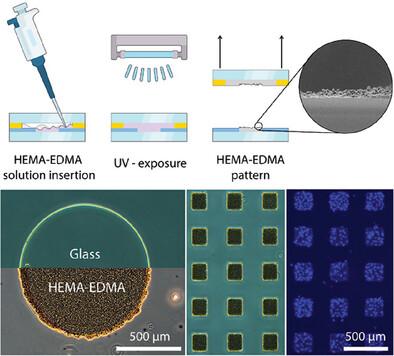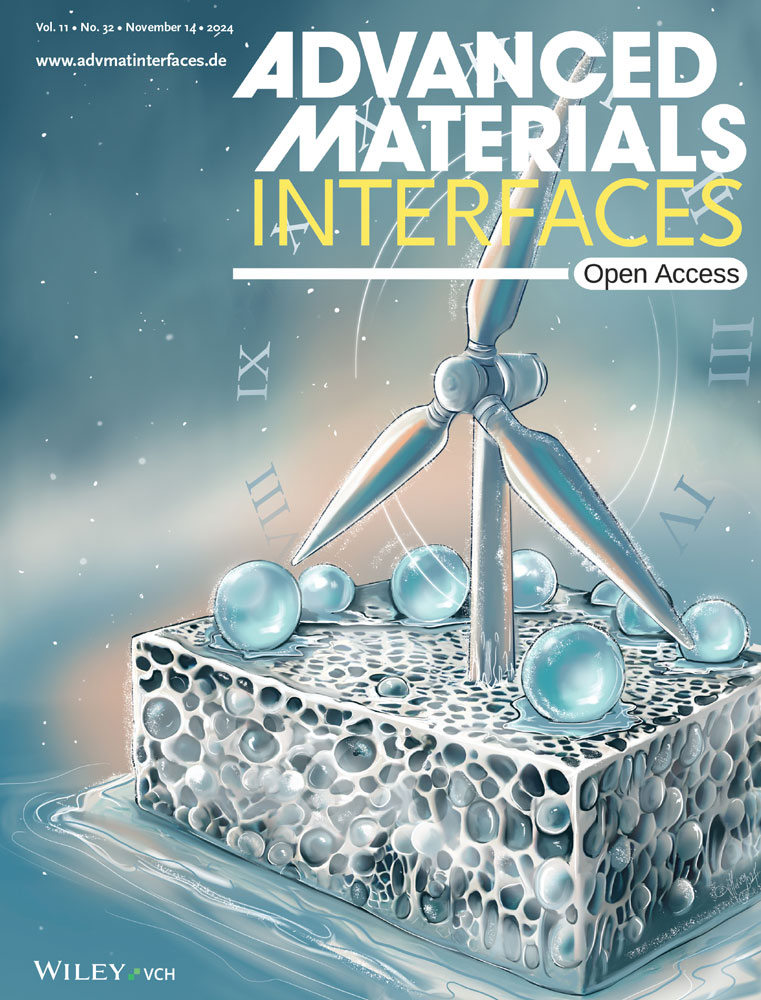Omniphobic Photoresist‐Assisted Patterning of Porous Polymethacrylate Films
IF 4.3
3区 材料科学
Q2 CHEMISTRY, MULTIDISCIPLINARY
引用次数: 0
Abstract
Patterning of various surface properties, including roughness, wettability, adhesiveness, and mechanical properties, can markedly enhance the functionality of test systems. Thus, porous polymethacrylates prepared by polymerization‐induced phase separation (PIPS) represent a promising class of functional materials for the construction of miniaturized test systems. Different porosity, surface chemistry, and wettability are achieved in porous polymethacrylates with different precursor compositions. Nevertheless, only wettability microstructuring has been highlighted for these materials thus far. Here, the study presents a novel method for the direct and selective deposition of porous polymethacrylate films with different surface chemistry and porosity. The selective adhesion of omniphobic–omniphilic wettability patterns is used to facilitate the polymer pattern formation. The feasibility of patterning with different monomers and porogenic solvents is demonstrated. The topological study confirms the selective application of polymer structures with different thickness and roughness. The wettability characterization of the omniphobic material shows no significant changes caused by the operations performed. Thus, a new pattern with a greater difference in the wettability of the areas is produced in the process. Discontinuous dewetting of different liquids is performed. The use of poly(2‐hydroxyethyl methacrylate‐co‐ethylene dimethacrylate) (HEMA‐EDMA) modified patterns for precise living cell patterning is also demonstrated.

多孔聚甲基丙烯酸酯薄膜的全疏性光阻辅助图案化
对各种表面特性(包括粗糙度、润湿性、粘附性和机械特性)进行图案化可显著增强测试系统的功能。因此,通过聚合诱导相分离(PIPS)制备的多孔聚甲基丙烯酸酯是一类很有前途的功能材料,可用于构建微型化测试系统。不同前体成分的多孔聚甲基丙烯酸酯具有不同的孔隙率、表面化学性质和润湿性。然而,迄今为止,这些材料中只有润湿性微结构得到了强调。本研究提出了一种直接选择性沉积具有不同表面化学性质和孔隙率的多孔聚甲基丙烯酸酯薄膜的新方法。全疏-全亲润湿性图案的选择性粘附用于促进聚合物图案的形成。使用不同的单体和致孔溶剂进行图案化的可行性得到了证实。拓扑研究证实了不同厚度和粗糙度的聚合物结构的选择性应用。全疏性材料的润湿性特征表明,所进行的操作不会导致明显的变化。因此,在此过程中产生了一种新的图案,各区域的润湿性差异较大。对不同的液体进行不连续的润湿。此外,还展示了使用聚(2-羟乙基甲基丙烯酸酯-二甲基丙烯酸乙烯酯)(HEMA-EDMA)改性图案进行精确活细胞图案化的情况。
本文章由计算机程序翻译,如有差异,请以英文原文为准。
求助全文
约1分钟内获得全文
求助全文
来源期刊

Advanced Materials Interfaces
CHEMISTRY, MULTIDISCIPLINARY-MATERIALS SCIENCE, MULTIDISCIPLINARY
CiteScore
8.40
自引率
5.60%
发文量
1174
审稿时长
1.3 months
期刊介绍:
Advanced Materials Interfaces publishes top-level research on interface technologies and effects. Considering any interface formed between solids, liquids, and gases, the journal ensures an interdisciplinary blend of physics, chemistry, materials science, and life sciences. Advanced Materials Interfaces was launched in 2014 and received an Impact Factor of 4.834 in 2018.
The scope of Advanced Materials Interfaces is dedicated to interfaces and surfaces that play an essential role in virtually all materials and devices. Physics, chemistry, materials science and life sciences blend to encourage new, cross-pollinating ideas, which will drive forward our understanding of the processes at the interface.
Advanced Materials Interfaces covers all topics in interface-related research:
Oil / water separation,
Applications of nanostructured materials,
2D materials and heterostructures,
Surfaces and interfaces in organic electronic devices,
Catalysis and membranes,
Self-assembly and nanopatterned surfaces,
Composite and coating materials,
Biointerfaces for technical and medical applications.
Advanced Materials Interfaces provides a forum for topics on surface and interface science with a wide choice of formats: Reviews, Full Papers, and Communications, as well as Progress Reports and Research News.
 求助内容:
求助内容: 应助结果提醒方式:
应助结果提醒方式:


